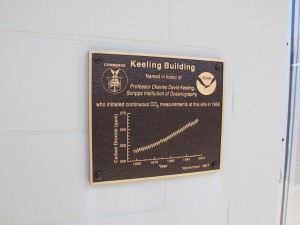 “Since the start of the industrial revolution, mankind has been burning fossil fuel (coal, oil, etc.) and adding its carbon to the atmosphere as carbon dioxide. In 50 years or so this process, says Director Roger Revelle of the Scripps Institution of Oceanography, may have a violent effect on the earth’s climate…
“Since the start of the industrial revolution, mankind has been burning fossil fuel (coal, oil, etc.) and adding its carbon to the atmosphere as carbon dioxide. In 50 years or so this process, says Director Roger Revelle of the Scripps Institution of Oceanography, may have a violent effect on the earth’s climate…
Dr. Revelle has not reached the stage of warning against this catastrophe, but he and other geophysicists intend to keep watching and recording. During the International Geophysical Year (1957-58), teams of scientists will take inventory of the earth’s CO2 and observe how it shifts between air and sea. They will try to find out whether the CO2 blanket has been growing thicker, and what the effect has been. When all their data have been  studied, they may be able to predict whether man’s factory chimneys and auto exhausts will eventually cause salt water to flow in the streets of New York and London.”
studied, they may be able to predict whether man’s factory chimneys and auto exhausts will eventually cause salt water to flow in the streets of New York and London.”
– “One Big Greenhouse“, Time Magazine, May 28, 1956
As part of the International Geophysical year, Revelle’s post-doctoral associate David Keeling established the CO2 monitoring station atop Mauna Loa in Hawaii (photos taken by an embarrassingly excited S. Donner). The now famous Keeling Curve is the longest continuous record of atmospheric CO2 measurements.
Funding for the regular measurements at Mauna Loa has long been an issue. You can now donate directly through a crowd-sourcing program to maintain this incredible record of planetary change.

Thanks Eli. Gore was fortunate to learn about the changes to the carbon cycle from Revelle himself. Perhaps that says something about how a good class, teacher or professor can have a real influence on people.
Revelle spent most of his academic life at Scripps, which became part of UCSD. When he was passed over for President of UCSD, in order to get out of the way he went to Harvard for fourteen years or so which is where Gore was in his class. Walter Munk has a lovely appreciation of Revelle with most of the details
Damn that Al Gore for going back in time and fooling all of the world’s scientists!
Roger Revelle was a professor at Cornell. One of his students was Al Gore.
Sorry, he was professor at the University of California, San Diego
Isaac Asimov had his first essay about this way back in the 1950s as well. I’m trying to get my hands on a copy.